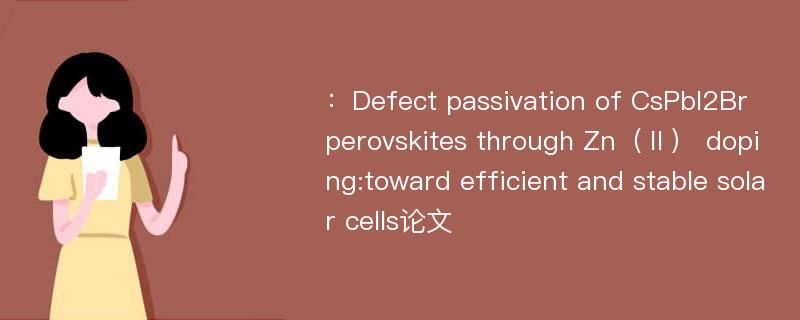
本文主要研究内容
作者(2019)在《Defect passivation of CsPbI2Br perovskites through Zn(Ⅱ) doping:toward efficient and stable solar cells》一文中研究指出:Defect passivation is an important strategy to achieve perovskite solar cells(PVSCs) with enhanced power conversion efficiencies(PCEs) and improved stability because the trap states induced by defects in the interfaces and grain boundaries of perovskites are harmful to both large open circuit voltage and high photocurrent of devices. Here, zinc cations(Zn2+) were used as a dopant to passivate defects of the CsPbI2Br perovskite leading to Zn2+-doped CsPbI2Br film with fewer trap states, improved charge transportation, and enhanced light-harvesting ability. Thus, the best-performance PVSC based on CsPbI2 Br with the optimal Zn2+doping shows a higher PCE of 12.16% with a larger open-circuit voltage(VOC) of 1.236 V, an improved shortcircuit current(JSC) of 15.61 mA cm-2 in comparison with the control device based on the pure CsPbI2Br which exhibits a PCE of 10.21% with a VOCof 1.123 V, a JSCof 13.27 mA cm-2. Time-resolved photoluminescence results show that the Zn2+doping leads to perovskite film with extended photoluminescence lifetime which means a longer diffusion length and subsequently enhanced photocurrent and open circuit voltage. This work provides a simple strategy to boost the performance of PVSCs through Zn2+doping.
Abstract
Defect passivation is an important strategy to achieve perovskite solar cells(PVSCs) with enhanced power conversion efficiencies(PCEs) and improved stability because the trap states induced by defects in the interfaces and grain boundaries of perovskites are harmful to both large open circuit voltage and high photocurrent of devices. Here, zinc cations(Zn2+) were used as a dopant to passivate defects of the CsPbI2Br perovskite leading to Zn2+-doped CsPbI2Br film with fewer trap states, improved charge transportation, and enhanced light-harvesting ability. Thus, the best-performance PVSC based on CsPbI2 Br with the optimal Zn2+doping shows a higher PCE of 12.16% with a larger open-circuit voltage(VOC) of 1.236 V, an improved shortcircuit current(JSC) of 15.61 mA cm-2 in comparison with the control device based on the pure CsPbI2Br which exhibits a PCE of 10.21% with a VOCof 1.123 V, a JSCof 13.27 mA cm-2. Time-resolved photoluminescence results show that the Zn2+doping leads to perovskite film with extended photoluminescence lifetime which means a longer diffusion length and subsequently enhanced photocurrent and open circuit voltage. This work provides a simple strategy to boost the performance of PVSCs through Zn2+doping.
论文参考文献
论文详细介绍
论文作者分别是来自Science China(Chemistry)的,发表于刊物Science China(Chemistry)2019年08期论文,是一篇关于,Science China(Chemistry)2019年08期论文的文章。本文可供学术参考使用,各位学者可以免费参考阅读下载,文章观点不代表本站观点,资料来自Science China(Chemistry)2019年08期论文网站,若本站收录的文献无意侵犯了您的著作版权,请联系我们删除。
